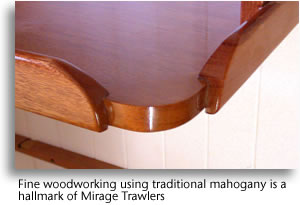 Trawler Construction Trawler Construction
By Ken Fickett
President, Mirage Manufacturing
Mirage has been a leader in advanced composites in the marine industry and in the aircraft industry for more than two decades. Understanding technology only goes so far. It is the ability to bring new materials and processes to the marketplace that separates the professionals from the dreamers. All too often, start-up companies building boats fail to integrate the appropriate technology in their boats.
Let’s start at the same place everybody does when they build a fiberglass boat, the Gelcoat. There are many to choose from and each can differ in color retention, ease of patching, and resistance to crazing. From worse to best, the per-gallon cost of gelcoat doubles. And yet the total cost of gelcoat used in a Mirage trawler is insignificant in proportion to the cost of the vessel. Why our competitors continue to use cheap gelcoat is beyond understanding. Next time you’re in the market for a new boat, demand that the manufacturer use Isothalic-NPG. That’s what we use, and it’s the best.
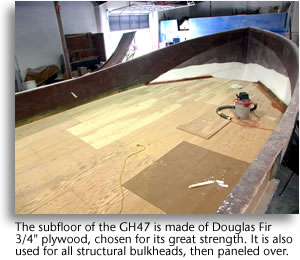 Once the gelcoat is sprayed into the mold, the lamination process can begin. Our opinion is that this is no place for a chopper gun spraying in short-strand fiberglass for the structure of your hull. Mirage trawlers are 100 percent hand-laid. Using fiberglass weaves means each layer is consistent throughout the hull. Each layer is individually wet out with resin with all air bubbles rolled out by hand. Our engineering department carefully monitors the number and placement of layers rolled into the hull. Both the style of the fiberglass weave and the type of resin that saturates the fiberglass is important to the overall quality of the hull. Once the gelcoat is sprayed into the mold, the lamination process can begin. Our opinion is that this is no place for a chopper gun spraying in short-strand fiberglass for the structure of your hull. Mirage trawlers are 100 percent hand-laid. Using fiberglass weaves means each layer is consistent throughout the hull. Each layer is individually wet out with resin with all air bubbles rolled out by hand. Our engineering department carefully monitors the number and placement of layers rolled into the hull. Both the style of the fiberglass weave and the type of resin that saturates the fiberglass is important to the overall quality of the hull.
We use vinylester resin in our hulls to preclude any potential osmotic blistering below the waterline and back that up with a five-year warranty against hull blisters. While some of our competitors follow suit, many do not. Make certain your next boat uses vinylester resin in the hull because the difference can mean tens of thousands of dollars in repairs down the road.
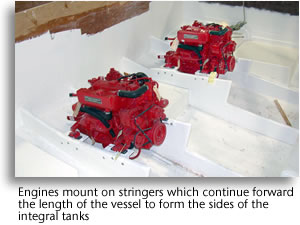 We do not use core in our trawler hulls. Although Mirage remains one of the industry experts in cored construction, we do not feel that it is appropriate in a vessel that will likely spend some portion of its life bouncing off rocks, gunkholing in the great cruising areas of the world. While coring the hull of some boats is the right thing to do we believe there is no place for it in the hull of a trawler. Take a core sample from the bottom of one of our hulls and you’ll find solid fiberglass laminates of more than an inch thick. Ask our competitors for a core sample from the same place, and be prepared for a surprise. We do not use core in our trawler hulls. Although Mirage remains one of the industry experts in cored construction, we do not feel that it is appropriate in a vessel that will likely spend some portion of its life bouncing off rocks, gunkholing in the great cruising areas of the world. While coring the hull of some boats is the right thing to do we believe there is no place for it in the hull of a trawler. Take a core sample from the bottom of one of our hulls and you’ll find solid fiberglass laminates of more than an inch thick. Ask our competitors for a core sample from the same place, and be prepared for a surprise.
Once we’ve completed the basic laminates of our hull we begin to install the interior structure. Mirage uses full-length longitudinal stringers with transverse frames to provide a structural grid pattern in the bottom of the hull. This grid provides the framing to support floors, mount engines and, very importantly, to provide the perimeter shape for our highly touted integral fuel tanks.
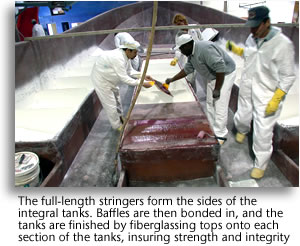 Most trawlers use aluminum or steel fuel tanks that have an undeniable history of failure. Some metal tanks may last up to twenty years, but many fail after only a few years in service, necessitating repairs that can cost tens of thousands of dollars. Mirage builds only vinylester/fiberglass structural and integral tanks. The fuel tanks built this way and so are the water and holding tanks. Lifetime tanks. The only way to go. Believe it. Most trawlers use aluminum or steel fuel tanks that have an undeniable history of failure. Some metal tanks may last up to twenty years, but many fail after only a few years in service, necessitating repairs that can cost tens of thousands of dollars. Mirage builds only vinylester/fiberglass structural and integral tanks. The fuel tanks built this way and so are the water and holding tanks. Lifetime tanks. The only way to go. Believe it.
Besides unparalled longevity, fuel tanks do double duty as a structural grid work to further reinforce the hull. The fuel tanks are heavily baffled to stop fuel from sloshing and their fiberglass construction greatly reduces water contamination from condensation. And finally, there is no way to nest tanks any lower in a vessel then by making them integral. This lowers the center of gravity in our trawlers, increases stability and thus makes for a more comfortable ride.
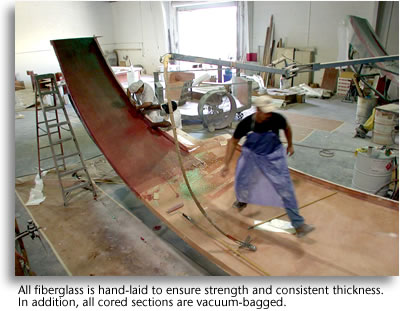 After the basic hull is complete, we begin building the superstructure. The superstructure is constructed very differently from the hull. Between the layers of fiberglass is a thick, lightweight core that is impervious to rot. The material is called Nida Core and is essentially honeycomb in section. This material is the best sound-deadening core available and additionally provides thermal insulation. After the basic hull is complete, we begin building the superstructure. The superstructure is constructed very differently from the hull. Between the layers of fiberglass is a thick, lightweight core that is impervious to rot. The material is called Nida Core and is essentially honeycomb in section. This material is the best sound-deadening core available and additionally provides thermal insulation.
The entire deck and pilothouse are constructed with core materials adding a huge amount of buoyancy to the vessel. This additional buoyancy overcomes the weight of the hull and machinery, which adds up to a huge plus-unsinkability. Most other fiberglass trawlers use plywood in the core of their decks because it is cheap. The problem is that it rots. Ask any repair yard what happens with plywood core, and then ask our competitors what they use. You will be surprised.
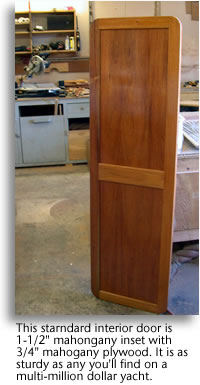 Another one of the outstanding differences in construction between us and our competitors is the degree of fiber glassing that is used to attach not only decks to hulls but also bulkheads to the decks and hulls. On many trawlers, structural bulkheads are in no way attached to the decks and even the hulls. This practice is completely unacceptable in a vessel that your life may some day depend on. All Mirage trawlers have all bulkheads bonded to hulls and decks with a special knitted biaxial fiberglass designed specifically for that purpose. Stop by at a boat show or come to our factory, and we’ll be happy to show you what you should demand in the way of bonding. Another one of the outstanding differences in construction between us and our competitors is the degree of fiber glassing that is used to attach not only decks to hulls but also bulkheads to the decks and hulls. On many trawlers, structural bulkheads are in no way attached to the decks and even the hulls. This practice is completely unacceptable in a vessel that your life may some day depend on. All Mirage trawlers have all bulkheads bonded to hulls and decks with a special knitted biaxial fiberglass designed specifically for that purpose. Stop by at a boat show or come to our factory, and we’ll be happy to show you what you should demand in the way of bonding.
When all of the fiberglass work is complete, and decks and bulkheads are installed, rigging and finish interior begins. We have often been called to work on competitors’ boats with molded inner liners. While there is nothing inherently wrong with an inner liner if executed properly, it is imperative that there is no hidden rigging. This is a process many builders use to shave time off the construction process, but trust me it is completely unacceptable. The builders will actually install plumbing and electrical to the backside of a liner and then glue the liner in place, rendering the rigging absolutely inaccessible. The only way to remedy the inevitable failures that come with age in hidden rigging is to saw away the fiberglass liner that hides it, a nasty, expensive job. Don’t let it happen to you. Make sure all rigging is installed after all fiberglassing and bonding is done. Look at the systems that are used on Mirage trawlers to carry electrical wiring. They are easy to access, add to, and repair. Make sure your boat is done the same way.
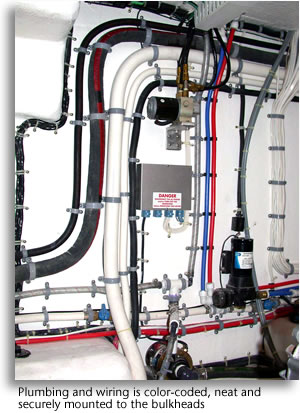 While we’re on the subject, we at Mirage have strong opinions about rigging itself. We believe in using the best materials because, again, the difference in cost in inconsequential compared to the benefits in longevity. All wiring is tinned double-jacketed boat cable. End terminals are high quality and well crimped with the proper crimping tool. Electrical systems are well thought out and laid out for ease of troubleshooting. Engine mounts are through-bolted, not installed with lag screws. We use dripless shaft seals on all of our trawlers to go the extra mile in our top-notch engine installations. Our fuel systems offer several layers of protection against fuel contamination and are easy understand. Fresh water plumbing is accessible; hot water hoses are identified. We install redundant bilge-pumps with the best automatic bilge pump switch money can buy. While we’re on the subject, we at Mirage have strong opinions about rigging itself. We believe in using the best materials because, again, the difference in cost in inconsequential compared to the benefits in longevity. All wiring is tinned double-jacketed boat cable. End terminals are high quality and well crimped with the proper crimping tool. Electrical systems are well thought out and laid out for ease of troubleshooting. Engine mounts are through-bolted, not installed with lag screws. We use dripless shaft seals on all of our trawlers to go the extra mile in our top-notch engine installations. Our fuel systems offer several layers of protection against fuel contamination and are easy understand. Fresh water plumbing is accessible; hot water hoses are identified. We install redundant bilge-pumps with the best automatic bilge pump switch money can buy.
At Mirage Manufacturing, we don’t like to use the word “overbuilt” for our trawlers, because tough construction and quality hardware are standard practice.
Our boats are not overbuilt - THEY’RE BUILT RIGHT!.
|





